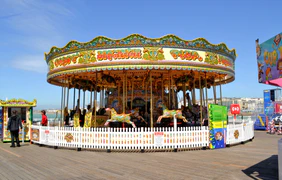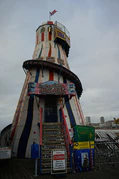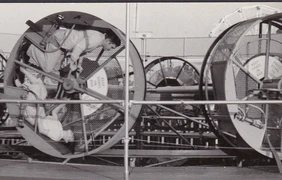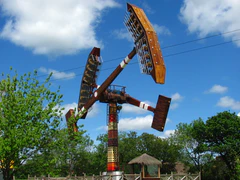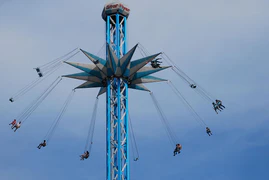Coasterpedia:Guide to ride types
More actions
(Redirected from Ropes course)

This is a working list of different ride types. Please feel free to expand it or discuss it on the discussion page.
Flat rides
- All-Round
- Ark/Speedway
- Autodrome
- Barnstormer
- Barnyard
- Bubble Bounce
- Cliffhanger ? https://keansburgamusementpark.com/rides/cliffhanger/
- Cobra
- Crazy Shake
- Extraordinary Bike
- Flight Trainer
- Fly-O-Plane
- Loop-O-Plane
- Mega Mix
- Monte Carlo Rally/Speedway
- Ramba Zamba/Swingaround/Hurricane
- Rodeo
- Roll-O-Plane
- Scat
- Simulator
- Swinging Gyms
- Tango
- Tip Top/Force 10
- Toboggan Waterslides (similar to Dhingy Waterslides, below)
- Whirligig
List
Table
| Name | Notes | Type | Product | Category |
|---|---|---|---|---|
| Acrobat | Circle | |||
| Air Race | A product from Zamperla. | Circle | ||
| Balloon Race | Circle | |||
| Balloon Tower | Tower, circle | |||
| Bayern Kurve | Circle | |||
| Booster | Swing | |||
| Breakdance | Circle | |||
| Cakewalk | An old ride with moving walkways that riders must navigate. | Walk-through | ||
| Calypso | Like a "Twist"/"Scrambler" ride but tilted. | Circle | ||
| Capriolo | A product from Mondial. Similar to a Booster, but only one end of the arm has a gondola. | |||
| Carousel | Includes Gallopers and double-decker rides. Also known as Merry-go-Round or Roundabout. | Circle | ||
| Caterpillar | Circle | |||
| Chair-O-Plane | A spinning ride. Does not tilt, unlike the Waveswinger. Includes Intamin Flying Dutchman? | Circle | ||
| Chaos | A product from Chance Rides. | Circle | ||
| Condor | A HUSS product, though similar rides have since been produced by Chinese companies. | Tower | ||
| Cobra | ||||
| Crazy Daisy | Circle | |||
| Cycle Monorail | Track | |||
| Dinghy Waterslides | Track, water | |||
| Disk'O | Introduced by Zamperla, now built by multiple companies. | Track | ||
| Dodgems | Also known as "Bumper Cars". | |||
| Drop Tower | Tower | |||
| Enterprise | Circle | |||
| Evolution | Similar to a frisbee ride that makes a full inversion, but the seats also tilt. Both Fabbri and Nauta Bussink have made these. | |||
| Experience | A product from KMG. | |||
| Ferris Wheel | Also known as Big Wheel. | |||
| Flight Trainer | A product from Intamin. | Circle | ||
| Flipper | Also known as Superbowl. Superbowl/Flipper | |||
| Flying Carpet | Also known as a Magic Carpet. Riders face toward each-other. | |||
| Flying Coaster | Circle | |||
| Flying Island | An observation ride from Intamin. | |||
| Flying Scooters | Circle | |||
| Free Fall | "Free Fall" was an Intamin product. Intamin is the only company that has produced this sort of ride. Unlike later drop tower rides, this was a tracked ride. | Track, tower | ||
| Frisbee | Includes fully inverting frisbee rides, variants with seats facing outward, inward, and the original inward-facing seats with floor. | Swing | ||
| Funhouse | A walk-through attraction. | Walk-through | ||
| Giant Slide | Also known as Astroglide or Fun Slide. | Slide | ||
| Happy Swing | A product from Zamperla. | |||
| Helter Skelter | Also known as a Slip. A spiral-shaped slide. | Slide | ||
| Hexentanz | A product produced by Zierer. | |||
| Hot Air Balloon Ride | A product produced by W.G.H. Transportation Engineering | Tower | ||
| Inverter | ||||
| Jets | Small vehicles spin round a central point. Each gondola rises and falls independently of another. | Circle | ||
| Jolly Tubes | Simple faiground ride consisting of a walk-through hollow spinning tube. | Walk-through | ||
| Jump & Smile | Circle | |||
| Log Flume | Track, water | |||
| Looper/Rock 'n' Roll | Circle | |||
| Madhouse | Large motorised type. Includes Vekoma Mad House and Mack Mystery Swing rides. | |||
| Magic | A product from HUSS. | |||
| Matterhorn | Circle | |||
| Miami | ||||
| Miniature Railway | Only railways within parks are covered. | Track | ||
| Mixer | A product from Zamperla. | |||
| Monorail | May be used for transport and/or observation. Only monorails within parks are counted. | Track | ||
| Moonrocket | Produced by Maxwell and Lakin in the UK and Allan Herschell in the US. | |||
| Move It | Also known as Spin Out. The entire platform on which this ride sits, spins. | |||
| Musik Express | Aso known as Superbob. Information | Circle | ||
| NebulaZ | A product from Zamperla. | |||
| Observation Tower | Spinning observation tower. Single or double-decker. | Tower | ||
| Octopus | Fairly simple spinning ride with rising and falling cars. Could be viewed as a simpler version of the Polyp. | Circle | ||
| Orbiter | Also known as Extreme. | Circle | ||
| Paratower | A tower ride with parachutes. | Tower | ||
| Paratrooper | ||||
| Pegasus | A product from Technical Park. | |||
| Pirate Ship | Also known as Galleon. A non-inverting pendulum ride. | Swing | ||
| Polyp | Circle | |||
| Pony Trek | Track | |||
| Power Surge | A product from Zamperla. | |||
| Quasar | A spinning ride that looks similar to an Enterprise, but it doesn't tilt up, rather it wobbles while spinning. | Circle | ||
| Ranger | Also known as a Traum Boot. | Swing | ||
| Rainbow | Also known as Ali Baba. Riders face outward. Usually has a single boom but includes the Chance Falling Star which has two. | Swing | ||
| River Rapids | Track, water | |||
| Rock-O-Plane | Looks like a ferris wheel, but riders can control the vertical spinning of their car. A skilled rider can apply the brake to perform loops or keep their car upside-down. | |||
| Rockin' Tug | Smaller than a Disk'O | Track | ||
| Ropeway | Also known as Cable Car. | Track | ||
| Rotor | Also known as Gravitron. | Circle | ||
| Rotoshake | ||||
| Round-Up | Also known as Meteorite. Includes the more extreme HUSS "UFO" ride | Circle | ||
| Roundabout | Circle | |||
| Satellite | Also known as Trabant. | Circle | ||
| Santa Maria | Also known as Shuttle Boat. A product from Schwarzkopf. Like a Pirate Ship on rails, or a Disk'O but with the spinning car swapped for a non-spinning pirate ship. | |||
| Scrambler | Also known as Cha Cha, Sizzler, Twist. | Circle | ||
| Screamin' Swing | A product from S&S Worldwide. A giant swing ride which does not spin. | Swing | ||
| Sea Storm | Circle | |||
| Shoot The Chute | Track | |||
| Skid | Also known as Swirl, Ben Hur. | |||
| Skycoaster | ||||
| Sky Fly | A product from Gerstlauer. | |||
| Sky Racer | Originally a product from Gerstlauer, later copied by SBF Visa | |||
| Sky Roller | A product from Gerstlauer | Tower | ||
| Sky Sling | A product from S&S Worldwide. | |||
| Sky Swat | A product from S&S Worldwide. | |||
| Sky Wheel | Also known as Double Ferris Wheel. Produced by Allan Herschell Company who were acquired by Chance Rides in 1970. | |||
| Slingshot | ||||
| Splash Battle | Track, water | |||
| Star Flyer | Tower | |||
| Steam Yachts | A ride produced by Savage. | |||
| Super Loop | Also known as Ring of Fire. | Track | ||
| Super Nova | Super Nova produced by Mondial, Canyon Trip produced by Soriani & Moser. Like a Vekoma Waikiki Wave but the seats face inward, towards the centre of the ride. | |||
| Superstar | Produced by UK firms Protech and Northern Amusements. Riders sit at the end of arms attached to a spinning central point. This is in turn attached to an arm which raises riders into the air then also spins. | |||
| Tagada | Circle | |||
| Take Off | ||||
| Teacups | Circle | |||
| Tempest | ||||
| Tilt-A-Whirl | Circle | |||
| Top Spin | Includes variants such as Waikiki Wave by Vekoma, where each arm is able to rotate independently. | |||
| Top Scan | A ride with a single arm with seats at the end. The seats rock while the arm moves to create a unique ride experience. | |||
| Tornado | Riders sit in four-person suspended cars, whose spinning can be controlled by the rider. These cars are suspended from a central, spinning tower. | |||
| Tri-Star | A product from HUSS. | |||
| Troika | Circle | |||
| Tube Slide | Slide | |||
| Tumble Bug | A ride with a circular track with one or more bumps. Features a "train" which is attached to a central spinning point. Includes the original Traver "Tumble Bug" rides and the modern "Bayern Express" rides from Gerstlauer. | Circle | ||
| Twin Spin | A product from A.R.M. Riders sit on a spinning disc which is raised up and spun vertically. | |||
| Twist 'n' Splash | A combination of Tea cups and a Splash battle | Circle, water | ||
| Typhoon | Similar to the Passat ride (a precursor to the Enterprise), but the spinning section of the ride travels up and over an upside-down U shaped track. | |||
| Waltzer | Similar to a Tilt-A-Whirl, popular in the UK. | Circle | ||
| Waveswinger | Like the Chair-O-Plane, but the top part tilts when the ride is at speed. | Circle | ||
| Whip | ||||
| Zipper | A product from Chance Rides. |
Image gallery
Images required:
Omitted rides
Due to their size, ubiquity, and difficulty to track, some attraction types are deliberately omitted from ride lists. These attractions do not warrant articles, though where reliable sources are available information on them may be added in the "History" section on the amusement park page.
- Arcade games
- Bumper boats or bumper cars that don't pick up power from the ceiling or floor
- Cinema attractions, even if they use ride-like gimmicks
- Go-Karts not within parks with other amusement rides
- Miniature Railways not within parks with other amusement rides
- Rides or Simulators that are coin-operated
- Meet-and-greet character facilities unless the experience is optional and has a walk-through attraction connected to it
- Playgrounds
- Ropes Course
- Splash Pads
- Walk-Through attractions not within parks with other amusement rides













